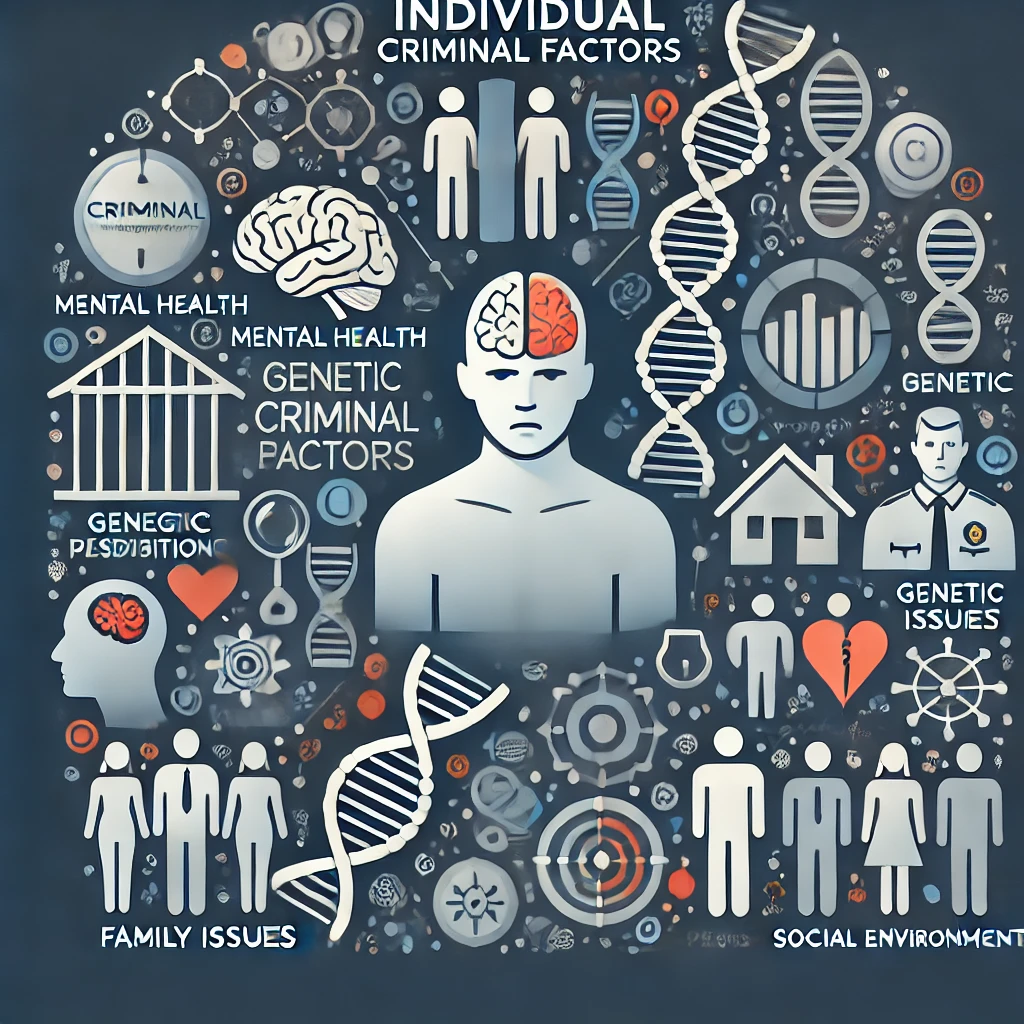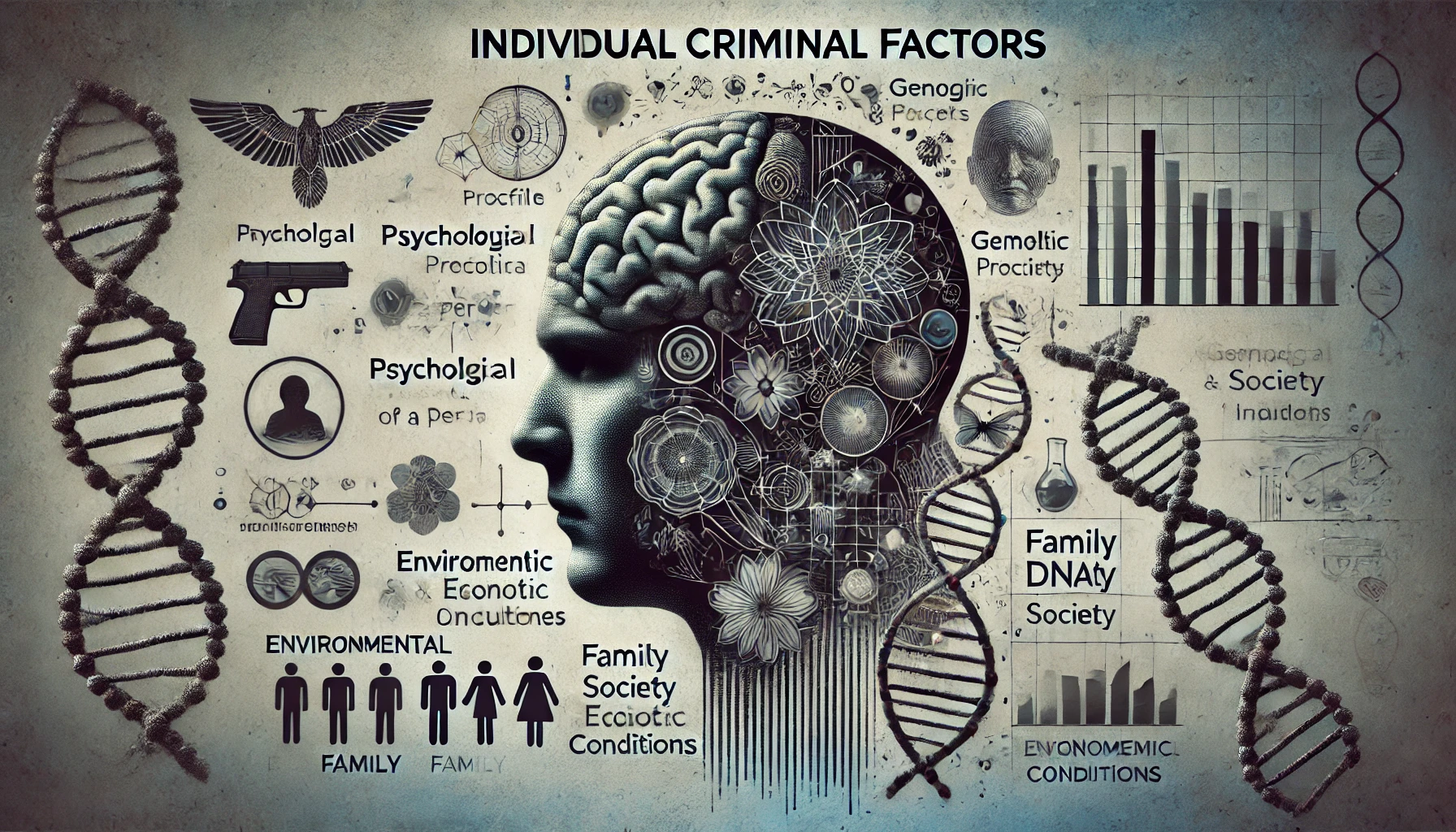Introduction
Crime is a complex and multifaceted phenomenon resulting from the interplay of various psychological, biological, and social factors. To understand the deep roots of criminal behavior, it is essential to highlight the individual factors that play a crucial role in shaping criminal tendencies. These include personal characteristics, psychological disorders, genetic influences, and environmental upbringing.
In this article, we will explore in detail the individual criminal factors, highlighting the views of prominent thinkers in this field such as Sigmund Freud, Cesare Lombroso, and Hans Eysenck, while also presenting examples and recent studies that contribute to enhancing our understanding of these factors.
Section One: Psychological Factors and Their Impact on Criminal Behavior
1.1 Psychological Theories
Psychological theories are among the fundamental frameworks for understanding criminal behavior. Many psychologists believe that crime arises from internal conflicts or disruptions in psychological balance.
- Sigmund Freud: Freud explained in his psychoanalytic theory that the human psyche consists of three components: the id, ego, and superego. According to Freud, crime occurs when an individual fails to control their aggressive impulses, especially when the “ego” is unable to mediate between the desires of the “id” and the moral standards of the “superego.”
- Hans Eysenck: Eysenck suggested a connection between personality traits and criminal behavior. He argued that individuals with high levels of extroversion and impulsivity are more likely to engage in criminal behavior due to their weak ability to learn moral values.
1.2 Mental Disorders and Criminal Behavior
Mental disorders play a significant role in steering some individuals towards criminal behavior:
- Personality Disorders: Conditions such as psychopathy, characterized by a lack of empathy, impulsivity, and guilt, are closely linked to criminality.
- Real-World Examples: Studies have shown that many perpetrators of violent crimes suffer from mental disorders, including bipolar disorder and schizophrenia.
1.3 Intelligence and Deviance
Intelligence levels are linked to crime in various ways:
- Henry Goddard: He noted that individuals with low intelligence tend to commit unplanned crimes due to their inability to predict consequences.
- Recent Studies: Research has indicated that low emotional intelligence is associated with difficulty in controlling aggressive behaviors.
Section Two: Biological and Genetic Factors
2.1 Classical Biological Theories
- Cesare Lombroso: Lombroso is considered the pioneer in biological studies of crime. He proposed that criminals could be identified by physical traits such as skull shape. Although his theory has been widely criticized, it opened the door for studying the relationship between biology and crime.
- William Sheldon: He introduced the “body type theory,” suggesting that individuals with a strong muscular build (mesomorphic) are more prone to aggressive behavior compared to other body types.
2.2 The Role of Genetics in Criminal Behavior
- Twin Studies: Research has shown that identical twins exhibit more similar criminal tendencies than fraternal twins, highlighting the genetic role.
- Richard Dugdale: In his study of the Jukes family, he noted the transmission of criminal tendencies across generations.
2.3 The Impact of Neuroscience and Biochemistry
- The Brain and Crime: Neuroimaging studies have shown that disruptions in the frontal lobe (responsible for decision-making) are linked to aggressive behaviors.
- Hormones: Increased testosterone levels in males are associated with aggressive behavior.

Section Three: Social and Environmental Factors Influencing the Individual
3.1 Socialization and Its Relationship with the Individual and Crime
- Albert Bandura: Bandura suggested that criminal behavior can be learned through observing and imitating others.
- Family Environment: Families suffering from breakdowns or domestic violence contribute to the development of criminal tendencies.
3.2 Economic Pressures and Their Impact on Individual Crime
- Émile Durkheim: He discussed “anomie” (the absence of norms) as a key factor in increasing crime rates.
- Robert Merton: Merton proposed the strain theory, which suggests that the gap between societal goals and legitimate means to achieve them leads individuals to deviate.
3.3 The Interaction Between the Individual and the Environment
The interaction between individual factors and the surrounding environment is clearly demonstrated in studies of marginalized communities and areas suffering from social exclusion.
Section Four: Integration of Theories and Their Evaluation
4.1 The Importance of Integrating Psychological, Biological, and Social Factors
- Integrated Models: The biosociological model of crime integrates these factors.
- The Importance of This Approach: It provides a comprehensive and accurate picture of crime understanding.
4.2 Recent Trends in the Study of Individual Factors
- Genetic Analysis: Genetic analysis helps identify genes linked to criminal behavior.
- Artificial Intelligence: AI has become an effective tool for analyzing crime data and predicting criminal trends.
Conclusion
Individual criminal factors are key to understanding the motivations behind criminal behavior. By studying the psychological, biological, and social aspects of individuals, we can design effective programs for prevention and rehabilitation. Crime is not just an external act but a reflection of internal struggles and complex environmental interactions. Researchers must continue exploring these factors to provide practical and sustainable solutions to reduce this phenomenon.

